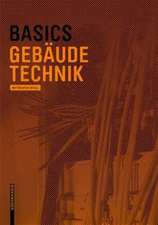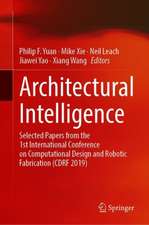Architecture in the Age of Artificial Intelligence: An Introduction to AI for Architects: Architecture in the Age of Artificial Intelligence
Autor Neil Leachen Limba Engleză Paperback – 15 dec 2021
Artificial intelligence is everywhere - from the apps on our phones to the algorithms of search engines. Without us noticing, the AI revolution has arrived. But what does this mean for the world of design? The first volume in a two-book series, Architecture in the Age of Artificial Intelligence introduces AI for designers and considers its positive potential for the future of architecture and design.Explaining what AI is and how it works, the book examines how different manifestations of AI will impact the discipline and profession of architecture. Highlighting current case-studies as well as near-future applications, it shows how AI is already being used as a powerful design tool, and how AI-driven information systems will soon transform the design of buildings and cities.Far-sighted, provocative and challenging, yet rooted in careful research and cautious speculation, this book, written by architect and theorist Neil Leach, is a must-read for all architects and designers - including students of architecture and all design professionals interested in keeping their practice at the cutting edge of technology.
Preț: 136.54 lei
Nou
26.13€ • 27.35$ • 21.62£
Carte disponibilă
Livrare economică 15-29 martie
Livrare express 04-08 martie pentru 29.58 lei
Specificații
ISBN-10: 1350165514
Pagini: 272
Ilustrații: 80 bw illus
Dimensiuni: 138 x 216 x 18 mm
Greutate: 0.48 kg
Editura: Bloomsbury Publishing
Colecția Bloomsbury Visual Arts
Seria Architecture in the Age of Artificial Intelligence
Locul publicării:London, United Kingdom
Caracteristici
Notă biografică
Neil Leach is an architect and theorist. He teaches at Florida International University, USA, the European Graduate School, Switzerland, and Tongji University, China. He has also taught at many other leading schools of architecture, including the Architectural Association, UK and Harvard University's Graduate School of Design, USA; he is a member of the European Academy and has been a NASA Innovative Advanced Concepts Fellow. He has published over 30 books on architecture and digital design, translated into six languages.
Cuprins
List of Illustrations Acknowledgements Preface IntroductionAI and ArchitectureBeyond TechnophobiaThe Prosthetic ImaginationCyborg CultureExtended IntelligenceAn Introduction to AIIntended Audience1. What is AI?The Different Forms of AITraining TechniquesAI TribesNeural NetworksBackpropagationConvolutional Neural NetworksDeepDreamGenerative Adversarial NetworksFrom 2D to 3DArchiGANBeyond Representation2. The History of AIAlan TuringThe Birth of AIAI WintersDeep BlueJeopardy!AlphaGoSputnik MomentAI and Visibility3. AI, Art and CreativityA Brief History of AI ArtWho Needs Gauguin?But who is the Author?Rethinking CreativityIn the Mirror of AI4. AI, Media Art and NeuroscienceDreaming MachinesDreaming BuildingsMachine HallucinationsArchitecturalisationsCan Machines Dream?5. AI and ArchitectureCoop Himmelb(l)auMorphosisZaha Hadid ArchitectsAI Fabrication6. The Future of the Architectural OfficeSuperusersAutodesk v the SuperuserDeveloper AISpacemaker AIXKool TechnologySpacemaker v XkoolRe-Designing Design7. AI and the City of the Future iPhone CityThe Information ArchitectThe Informational CityAmbient IntelligenceSwarm IntelligenceThe Self-Regulating CityCity BrainInternet-City-Brain8. The Future of AIKurzweil's PredictionsThe SingularityAGI and BeyondPrediction ErrorsThe Future of IntelligenceArchitectural IntelligenceAI and the Future of ArchitectureNotes Index
Recenzii
A brand new set of tools has inspired a new wave of transformative creative energy within architecture. This book is essential reading for all who want to join the thrilling quest of bringing the power of AI into architecture.
Clearly written and well informed, this book is an indispensable resource for anyone interested in AI and its potential application in architecture.
















